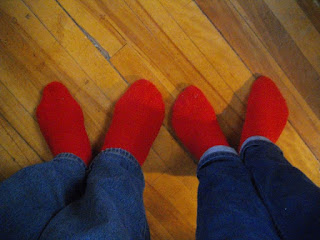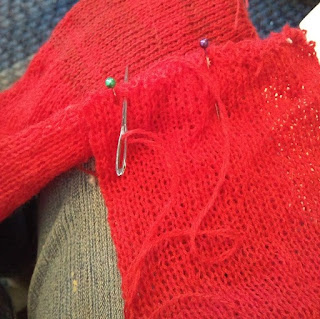I have a Sock Machine... or three. I bought 3 sock machines 18 years ago before they were popular and hard to find. They came with lots of spare needles, the original books and lots of tools and a stand! All for only $85!!!! Enough gloating...
My sister and I had set out to find out more about these machines and joined a group of enthusiasts in Pennsylvania. There we met with other men and women who came up with more than just socks that can be made on these machines.
Every winter I take the machine out and make some socks. My love of socks began with knitting them the old fashioned way on needles and I still do when traveling around the country. They are fun and easy to make.
Being home for the winter, I started looking on line for slipper patterns to knit. I found a great blog with directions for this "Felted Norwegian Slipper" pattern.
For a wonderful blog on knitting these on needles, check out this blog...
https://braindropskeepfalling.wordpress.com/2012/05/02/norwegian-house-slippers/
I started working on these with my needles, but in process I thought, maybe I could make them faster on the sock machine. It has been hovering around 0 degrees here in Connecticut for about 2 weeks and my old house floors are rather chilly. My daughter did not knit me a new pair of slippers this year, :), so I need to make some on my own.... fast.
I find cones of yarn at thrift stores and weaving groups and I have a very large cone of thin, red wool. It is so thin that when I made socks two years ago for my sweetie and I for Valentines day, I found that if I knitted them on the machine very loose I could felt them down to the proper size and they came out comfy and cozy.
So why not use this red yarn, loose tension, on the sock machine to make these Norwegian slippers?
They would be double and if knitted loosely, they would be felted down to a fine slipper.
So here is what I did.
I knitted the two sole squares with an added thread of Wooly Nylon. You can do these in various color squares, but I wanted them all red, so I put a bit of white thread on each side to mark the corners so I could sew them together properly later. My favorite machine cam has 60 needles. This is good for fingering yarn and makes a bulky sock. I used very loose tension so they would come out large and loose. The squares came out 5" wide (doubled of course) and 40 rows made each square 5" long. You need two sections, mark them by some waste yarn. The shrunken sole came out 9 1/2" long from heel to toe. I would say ladies size 7 or 8. In felting them, you can felt by hand and stop the process for a little larger size.
One thing that took FOREVER is that I used the kitchener stitch to connect the openings in the tops and bottoms of both sections so they would not unravel and would fall flat in two layers.
Lock in the first row with the mock rib fold. To do this, knit 2 or 3 rows, stop and with a crochet hook, reach in and pick up each loop from first row and place over hook. Move cam to be sure you got all stitches and continue your sock. This top will not unravel . Kitchener bottom.
I plan to try some other sizes by taking out some needles for kids slippers. ( If you take every other needle out of your machine, you get a nice small kids size sock.)
Here is how I did them.
Mark the sides with scrap yarn for later lineup. If you have not already done so, I have marked halfway points on my cam with nail polish.
Pick up on needles, half and half. Use those marked lines above so they line up.
Kitchener stitch... will zig-zag on sewing machine be faster and work ok?
Short piece, two squares lying double flat with white thread to mark the corner of each square.
Sew the 2 square piece to the 6 square piece using whip stitch.. same yarn doubled but not too tight.
Two pieces together. Notice two soles pieces have brown wooly nylon knitted in. It came out a little tighter than the straight red pieces, but felted ok.
Finished slipper, very loose and floppy. Follow the chart from that other great blog above. Check out her blog directions too, they are great!
Finished slipper, still very loose and floppy and about 2 inches longer than my foot.
Felted slipper. Don't know how to felt yet? Boy, is it fun. You can throw them in a washing machine with warm water and soap with your laundry, but I like to keep an eye on it. I use a pan of hot water and a bar of soap. Wet the slipper, squeeze out some water so it doesn't drip. Smear with soap and start squishing between your hands. Keep squishing, more soaking in hot water, more soap, until the slipper looks the right size. Rise in cool water and dry.
Have fun, let me know how it goes or if you have suggestions, and sign up for future blogs on other things you can do with your sock machine... Christmas wreaths, kid socks, scalloped edges, lacey patterns, door stops, cell phone bags, hats and more.
Sock machines... more fun than you realized and in half the time of needle knitting! Yes I love to knit by hand when away from home or at my groups, but sock machines are a great tool.






















